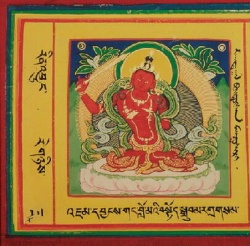Forms of Arapachana Manjushri
There are four basic forms of Manjushri that are either called Arapachana by name or use the Arapachana syllables as the principal mantra for the deity. The first is Arapachana, orange in colour, sometimes white. He holds a sword in the right hand and the stem of an utpala flower supporting the Prajnaparamita text in the left. The second form is Manjushri associated with a famous Sanskrit praise, orange in colour. The third form is Arapachana, white in colour, sometimes orange, with the two hands holding the stems of two utpala flowers supporting a sword and text. The fourth , Vidyadhara Pitika , is similar to the second form except white in colour and with the left leg pendant.
All forms of Arapachana Manjushri are peaceful in appearance. There are also many other forms of Manjushri that are peaceful but do not use the Name Arapachana or the arapachana mantra. Also, not all forms of Manjushri are peaceful. The principal examples of semi-wrathful and wrathful appearance are Black Manjushri as semi and then the many forms of Vajrabhairava, Krishna Yamari, Rakta Yamari and Manjushri Nagaraksha.
On the illustrated example page provided above there are four additional images of Manjushri related to Arapachana. These are found on a mandala painting of Vagishvari Dharmadhatu. The painting depicts twenty-three peaceful forms of Manjushri, three wrathful forms known as Yamari, and three mandalas in total.
